The post I Of The Sun: A Journey Into Southeast Asia And The Heart Of Human Consciousness appeared first on The Expeditioner Travel Site.
]]>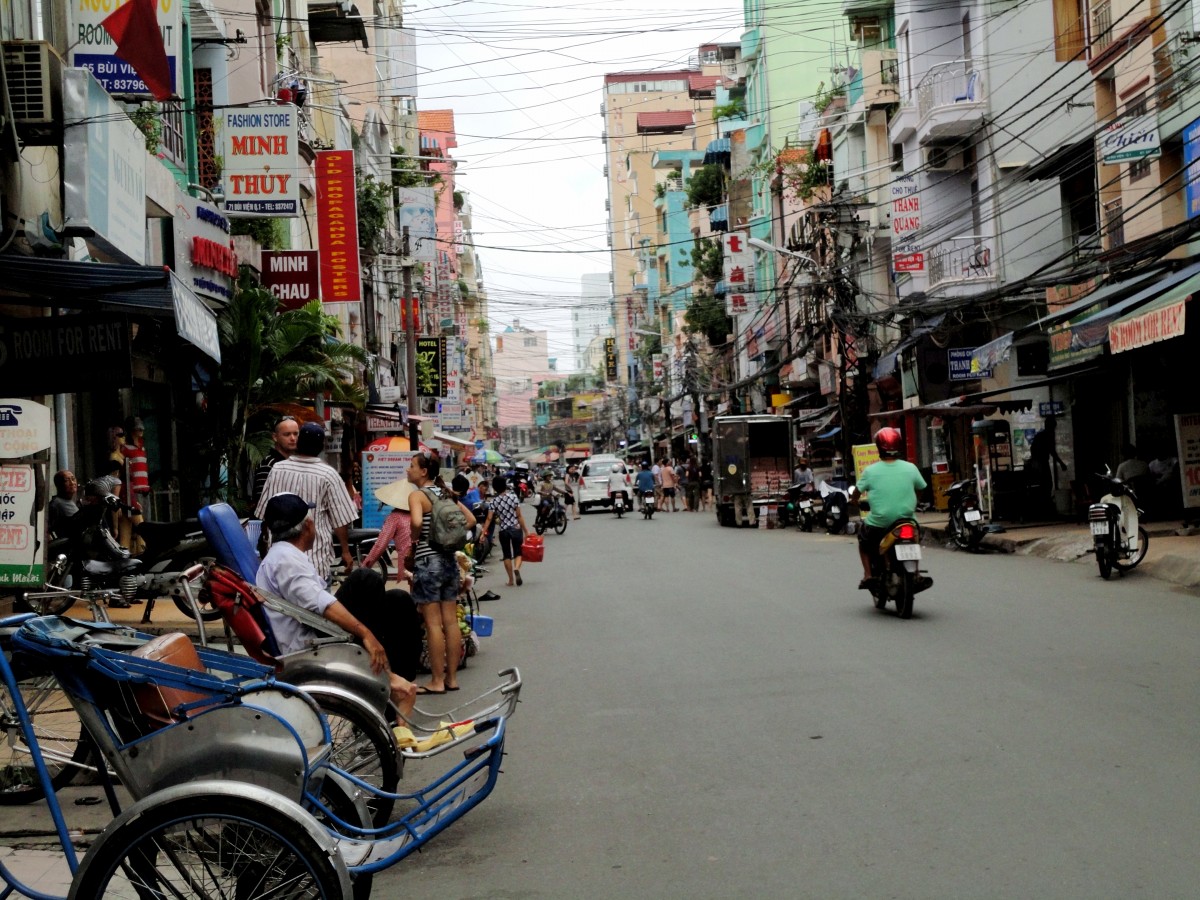
The following is an excerpt from I of the Sun: A Journey into Southeast Asia and the Heart of Human Consciousness by Richard Arthur.
The Cambodia/Vietnam border. The narrator is traveling with an Australian guy Vince who he met the day before. “Before me lay a huge red archway with five Khmer towers crowned above it with some faded yellow twirls of Cambodian script. Through the arch lay 200 meters of no-man’s land and then another white arch, glimmering in the distance like a mirage, a yellow star and one word in giant red letters – Vietnam.
Vietnam! A country I’d never imagined going to ‘until this day. A country known only to my young mind through the iconography of American pop culture – Adagio For Strings, choppers, gunshot, blood and tears. The beauty and the horror. It was October, the end of the rainy season. What was I doing here?
We crossed the border and changed bus. Instantly the pace was more frenetic. Endless streams of old mopeds buzzing around our bus like bats, brick houses by the road, lines and squiggles all over the letters of its Romanized language. More built up than Cambodia, though no Western brand names visible anywhere, just long terraces of shop houses by the side of the road, and occasional billboards for Asian companies. We barely saw any open countryside the whole way, just endless people, bikes and buildings.
We soon came to Ho Chi Minh City, formally known as Saigon. The city had a raw buzz, a feeling of unfinished business, case unclosed. The scarred beauty of tree-lined boulevards and tin-shack alleys, her arteries clogged with the burgeoning weight of humanity pumping through her soul. People everywhere, the streets electric! The energy grabbed me and squeezed my imagination like a vice. Thousands and thousands of 50cc rusty bikes and rickety old bicycles swarmed the streets, moving as one, each an individual atom in the large amorphous mass. When the lights went green they came at us like a swarm of bees.
Me and Vince found a cheap room in the heaving Pham Ngu Lao area of town where all the action seemed to be. That evening we went out for a few beers, taking in the buzz of the city, charged by the current of people out making money. It seemed like everyone was out to get you. Constant harassment from people following us down the road trying to sell us stuff we didn’t want; street-smart kids trying to charm and hustle money out of tourists, beggars and amputees lying in the gutter, and grinning motorcycle taxi drivers on street corners offering “Boom-boom? Marijuana?” under their breath.
Little women scuttling round in big pointy conical hats. Others selling their wares off motorbike side-cars, or carrying around two baskets of produce balanced on their shoulders with a heaving length of wood. Baguette ladies, noodle soup and sugar cane juice presses. Kids playing in the alleyways, the anxious mother, men unloading blocks of ice with metal hooks, pale white prostitutes driven round on mopeds, men cycling round with loud rattles, families eating by the road, the angry old grandmother, bandits in face masks, old hunchbacks, faces well worn from a thousand woes, the blind, the deaf, the mentally dispossessed, the missing limbs, the loss of kin, the chemical scars, twisted feet, human meat, lesser lives for the greater mass. A whole population living, working, eating and sleeping out on the streets.
And through the concrete madness of honking horns and beep-beep- beeps, the shuttlecock, the raggedy dog, the yellow-scarved soldiers in green, the docking ships of night and the smog of modernity; silently cruised the noble old cyclo drivers in shorts and rag shirts, bobbing on forever over their chariots – these three-wheeled rickshaws with a large passenger seat at the front, like a bicycle attached to a wheelchair – visions of serenity and melancholy calm. They were powered only by the old drivers, many of them homeless war veterans, out of sight, out of mind, destined to pedal ever onwards until the day their knees finally buckled and they died penniless in the gutter.
He catches up with two old friends from home who’ve flown out to join him on his travels into Vietnam, and they spend the next few days exploring the city.
“We carried on through the manic avenues and came to a long, wide road with bikes sifting round each other, fruit and spice stalls spread all over the road, paraplegics crawling through the dirt, no Westerners in sight, heads as far as the eye could see, a canopy of pointy hats. Thousands of people all on the go, movement, noise and heat overwhelming our enreefed little minds. It looked like a social uprising. A fear suddenly slashed through me like a switchblade. Where are they all going? What’s going on? Do they know something we don’t? Is there some kind of revolution going on? Jitters of panic in the echoes of history.
We continued onwards to a muddy little canal, traffic just inches from us till there were no pedestrians left, just relentless motorbikes blowing smoke and grime at us as we trudged along the side of a bypass road, often faster than the gridlocked motorcade. The heat, noise, smoke and exhaustion were starting to get too much to handle. We eventually climbed up and stopped on a pedestrian bridge over the muddy canal lined with slum shacks, exhausted by it all.
The faded colors of dusk and the dancing shadows eased the over-excited twinges of paranoia into a smooth appreciation of it all. It hit us then – the sheer beauty of the place. This was it! Vietnam! Asia! We’d found the picture of the East that we’d been looking for, here in Saigon. It had an insane, desperate clamor in the air, more than any other city I’d been to in Asia.
No tourists, no Western shops or restaurants, just millions of bicycles, dusty roads, old temples, handpainted signs, street markets, pointy hats and crushing poverty. This was the image of Asia I had in my head before I’d come here. That vague notion of the old Orient from the movies. Saigon was Asia as I’d imagined it would be. The heat, the energy, the 24-hour noise, history, violence, excitement, weed, rum and crazy dreams were all conspiring to drift us further from that which we knew. And we loved it. We let ourselves slide away into our imaginations, into a world of unlimited possibilities where fiction and dreams met reality, a world where we could do anything we wanted to. All we had to do was stop thinking about it, stop talking about it and just get out there and do it! The triumph of the will, Man as his own master.
We felt enlivened again. That night the four of us found a little bar with a pool table and a rack of cheap rum. We drank with gusto, liquor flowing through us fast into the gutter, little kids peering over the table moving the balls around playfully, Rolling Stones busting out the speakers. Joe had just fallen in love with a girl back home before he came out, and was missing her badly. Her name vaguely resembled Angie. When it came on, me and Charlie changed the words, ripping into him mercilessly. What are friends for? But still we continued, colored balls rattling round our minds, talk of fake passports and multiple identities, Joe raising toasts, Vince’s booming laugh, Charlie cracking gags, “Jumpin’ Jack Flash,” tequila, pot, smash!
We bowled out into the midnight tropics in twisted spirits and weaved through the crowded streets looking for some action. I stopped for a street vendor’s steamed dumpling and quickly lost the others, faffing around by myself in a drunken stupor. I sat down staring at the endless motorbikes, wondering what to do next. Then, out of the traffic appear two cyclos tearing down the road at high speed, Joe driving Charlie in one, and Vince steering the other. What the fuck? Joe and Vince have a look of positive insanity in their faces. Charlie looks terrified. No idea what they’re doing but I had no option. I burst out the shadows and jumped into the passenger seat of Vince’s cyclo, everyone cracking up at the seams!
We speed off, laughing neon maniacs of the night, trying not to stack the things as we zigzag across lanes, out of control through the traffic. I don’t know what’s going on, assuming they’ve nicked them. Seemed impossible to keep them in a straight line at this speed with the weight of the passenger attached to the handlebars. Next thing, we turn onto a larger road, and judging by the amount of cars and motorbikes, suddenly realize we’re on a highway. We’re dodging traffic, trying to keep the things in a straight line, hoping not to get mown down by the passing trucks, when the owners drive up alongside us on a moped screaming at us to get off the road. Somehow managing not to get hit, we turn off into a quiet side alley, but we ain’t done yet.
Me and Vince swap places, and I chase the others through the alleyways, amazed onlookers cheering on the crazy foreign bastards, ’till I see Joe’s crashed his cyclo into a parked moped up ahead. Getting closer. I look at the handlebars. “Shit! Where’s the brakes?” I scream. There are none. A sharp clattering screech of crashing metal. I smash into the back of the other cyclo, twisted spokes of bike everywhere, sending everything tumbling over. The moped driver’s standing in disbelief. The furious cyclo owners appear on their bike. Only then do the boys tell me they had just rented them for a short while. We left the situation with the vehicle owners and scattered into the bowels of the city like rats.

/
 This excerpt was taken from I of the Sun by Richard Arthur, available in paperback and ebook from Amazon and other retailers. For more info, check out www.IOfTheSun.com.
This excerpt was taken from I of the Sun by Richard Arthur, available in paperback and ebook from Amazon and other retailers. For more info, check out www.IOfTheSun.com.
The post I Of The Sun: A Journey Into Southeast Asia And The Heart Of Human Consciousness appeared first on The Expeditioner Travel Site.
]]>The post How To Cross The Street In Vietnam appeared first on The Expeditioner Travel Site.
]]>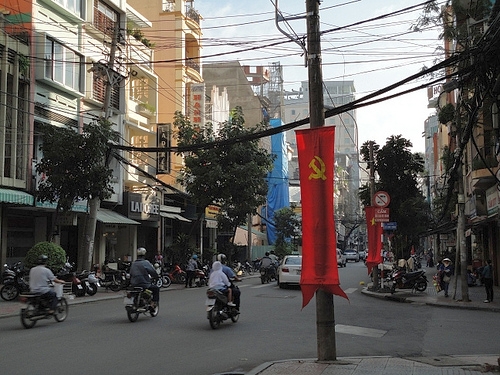
It sounds like the beginning of a joke: How do you cross the street in Vietnam? (Possible punchlines: “You don’t,” “You start by taking out a life insurance policy,” or “You buy a motorbike.”) As any visitor who has been to Vietnam knows, the quickest way to spot the newbie traveler in town is to look for a timid and bewildered expression on a Westerner’s face as they attempt to cross the street.
Given the seemingly endless gridlock of motorbikes everywhere, the complete lack of stoplights (or adherence to their rules) and the cultural assumption that crossing the street by foot is not something to done in any logical (or safe) manner, crossing the street in Vietnam can initially seem like an impossible task.
The NY Times recently wrote about the average tourists’ plight with the task of crossing the busy streets, and how hotels are resorting to handing out tip sheets entitled “How to cross roads” to help visitors make their way through the city. The reason for this recent problem? The answer, in short, is rapid development.
A decade or so of capitalist fervor has transformed Hanoi’s once-quiet, tree-lined boulevards and side streets into roaring rivers of rubber and steel. Tourists, when they are not cowering in their hotel rooms, can be spotted standing by the side of the road wearing expressions that range from startled to stupefied . . .
“Life was easy and calm,” Mr. Thinh said. “Now everyone is stressed; people want to make money.” He attributes the traffic conditions in Hanoi to migrants from the countryside, who ride through the packed, narrow streets according to the traffic rules of their home villages, which is to say none at all.
My own experience leads me to offer the following advise as to the best way to cross the street in Vietnam.
1) Forget about looking for a break in traffic, chances are you’re not going to find one. Accept this fact and move on.
2) Look in the direction of the source of traffic and enter the street.
3) Keep you head up and eyes toward the coming traffic as you make your way forward.
4) Despite your overconfident spacial reasoning and logic skills, don’t bother trying to walk in a manner timed to avoid collision. Simply walk straight at a slow and measured pace. Do not stop, slow or increase your speed. The reality is, the other drivers don’t want to hit you, and they will simply slow down and move accordingly around you. Erratic direction or speed changes will increase the likelihood of disaster.
5) Finally, be confident. Though you may seem like the underdog in this cat and mouse scenario, the truth is drivers are dealing with pedestrians all day long and are used to slowing down and slightly changing their direction to accommodate them. Timidity will simply throw off their timing and may land you in a Vietnamese hospital room.
To help things out a bit, try to placate your fears with plenty of street food around town and remember, the best part of the experience is how natural you will look to newly arrived visitors after you’ve spent a few days practicing.
The post How To Cross The Street In Vietnam appeared first on The Expeditioner Travel Site.
]]>The post Some Ideas After You’re Done With Halong Bay appeared first on The Expeditioner Travel Site.
]]>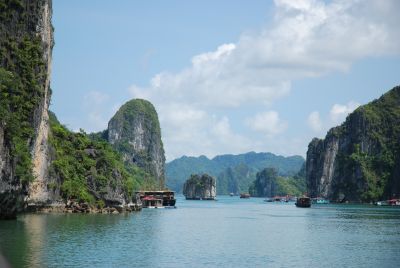
Chances are your visit to Halong bay will likely involve an armada of small boats jammed with backpackers and local tourists navigating the waterways between the limestone outcrops that make up Vietnam’s most recognizable landmark. But if you’re interested in seeing some other just as interesting but less crowded sites, Lonely Planet has a few other suggestions on what to see beyond Halong Bay.
For example, if you have time, head to nearby Cat Ba Island whose southeastern shores are home to its own limestone islands with isolated beaches, and where boat operators are likely to charge you a fraction of what you’ll pay in Halong.
Bai Tu Long, further north along the coast from Halong, promises to be noticeably less crowded than Halong, and features its own stunning landscapes and outdoor activities like hiking and cave exploring.
For more ideas check out their full article.
The post Some Ideas After You’re Done With Halong Bay appeared first on The Expeditioner Travel Site.
]]>The post Don’t Let Anyone Tell You Otherwise: The Lunch Lady Of Saigon Serves Meals To Die For appeared first on The Expeditioner Travel Site.
]]>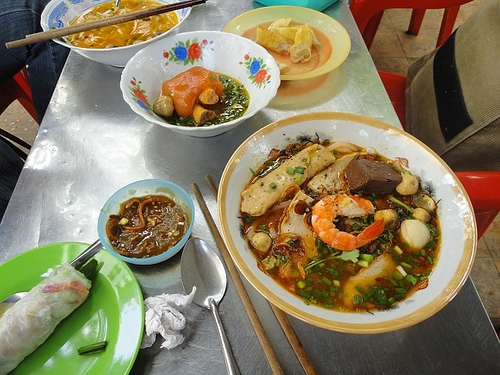
It’s rare that I will dig into a bowl of watery, bland soup here in the U.S. and I don’t harken back to happier times. Specifically, a certain afternoon in the bowels of Saigon sitting on a small, plastic chair chowing down on a freshly poured bowl of soup full of thick slices of meat, savory broth, giant-sized shrimp and a big blog of congealed pig blood (yes, pig blood). This piping hot bowl of ecstasy was given to me courtesy of the now famous Nguyen Thi Thanh, better known in the world as the “Lunch Lady” of Saigon, of No Reservation fame (and the countless viewers and food bloggers who have followed in Mr. Bourdain’s steps).
The Sydney Morning Herald recently sought ought Thanh to see what all the fuss was about, and they were surprisingly (dare I say smugly so) unimpressed with the offerings. Though expecting the usual Tuesday offering of bun moc (vermicelli noodles, shallots and spicy meat), instead they were served up “a broth of unshelled prawns, meat that can’t be identified and perfect noodles.” The chili impact was unexpectedly less than searing, and their final assessment: “I don’t know what I’m eating but I finish the lot. It’s good, not remarkable, but the obsession to find the ‘Lunch Lady’ has been satisfied.”
My guess is that all over street corners and courtyards throughout Vietnam, intrepid travelers can find “lunch ladies” whose daily offerings easily match up to Thanh’s, yet they lack the exposure that is given by being featured in an international travel show with a host gushing over their meals. However, as is the case anywhere in the world, there’s a reason certain restaurants and food stand have people lining up around the corner every day, and from my own personal experience, the Lunch Lady of Saigon should be one of those places.
I’m sure there are many more like her throughout the region, but she is hands-down one of the best places to begin your search, and don’t let anyone tell you otherwise.
The post Don’t Let Anyone Tell You Otherwise: The Lunch Lady Of Saigon Serves Meals To Die For appeared first on The Expeditioner Travel Site.
]]>The post 3 Tips To Haggling Prices In Vietnam appeared first on The Expeditioner Travel Site.
]]>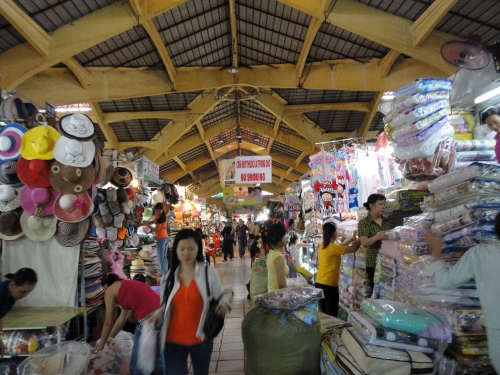
One of the biggest adjustments I had to make when I moved to Ho Chi Minh City, Vietnam, after college was the idea that it is perfectly acceptable, expected even, to argue with a merchant about the price of their goods or services. It’s just a part of life. A part that makes a lot of Westerners kind of uncomfortable.
After all, most bargaining is done over the equivalent of a pocketful of change. Whenever I translated my haggling into U.S. dollars, the whole process seemed almost obscene.
“How much to Tan Dinh Market?” I asked a xe om (motorbike taxi) driver. I had been living in Vietnam for a few months, and was half decent at using Vietnamese for asking “how much” and then shooting down numbers.
“94 cents,” he told me.
I immediately rolled my eyes and groaned. “Too expensive! 63 cents,” I countered.
The driver scoffed: “ 63 cents? No way. Too cheap. 75 cents.”
I gave in, but I was sure to look unhappy about it. I wanted him to know that I would take it, even though I knew better. “75 cents. Okay.”
20 cents: the kind of change that would be too little to tip a bartender back home.
But bargaining is commonplace around the world, especially in developing countries. And you should do it, no matter how silly/greedy/ashamed you feel about arguing over a few cents.
Here’s a primer on the art of haggling:
1) Why You Should Bargain
Economics
There are a few good arguments for engaging in epic arguments over prices, though the most pragmatic one might be a simple case study in economics.
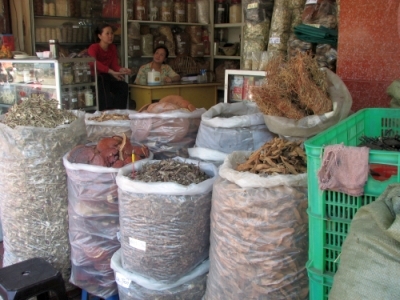 Imagine you have a shop in a Vietnamese market selling eggs. You can sell a dozen eggs to a local (who knows what the price should be and won’t buy if it’s excessively costly) for 15,000 dong (94 cents). But a tourist, who doesn’t know any better, is willing to pay 30,000 dong ($1.88).
Imagine you have a shop in a Vietnamese market selling eggs. You can sell a dozen eggs to a local (who knows what the price should be and won’t buy if it’s excessively costly) for 15,000 dong (94 cents). But a tourist, who doesn’t know any better, is willing to pay 30,000 dong ($1.88).
Now, you have a fixed supply: your chickens can only lay so many eggs. To maximize profits, it’s in your best interest to sell exclusively to foreigners at the higher price.
So the prices rise. Locals either can’t or won’t pay the asking price, but there are foreigners to buy the eggs. Your profits increase, but the local consumers don’t have any eggs.
In a nutshell: not haggling artificially inflates prices and is bad for the local economy.
Pride
In Vietnam, there is no social taboo against asking directly how much something cost. This is cultural standard, and if you pay too much someone will tell you.
Every time I came to work with a new bag/haircut/motorbike, someone asked me how much it cost. And every time it led to a full day of people approaching me to confirm the gossip, and then letting me know I had definitely paid too much.
Language practice
I promise you that there is no better way to learn to count in another language than through haggling with vendors. It also inspires you to memorize useful new phrases such as “too expensive” or “no, this is not real Gucci.”
2) When And Where To Bargain
Not every price is negotiable. Many legitimate taxi companies will only charge metered fares, and it would be in poor taste to try and talk your waiter into giving you a better price at a restaurant. So when and where do you start haggling?
A good rule of thumb is that if something has a price tag on it, the cost is non-negotiable. This includes restaurants, where prices are usually listed on menus or signs. Brick and mortar stores (as opposed to market stall) also typically have fixed prices.
In Ho Chi Minh City, there are some great markets where you can practice your haggling. Here are a few of my favorites:
Best for anything
Binh Tay Market (Thap Moi Street) is the wholesale destination for everything from dried shrimp to toothpaste to soccer jerseys.
Best for souvenirs.
Ben Thanh (Le Loi Street) is located smack in the middle of downtown and caters to the tourists that wander through.
Best for clothes
Saigon Square (near the intersection of Hai Ba Trung Street and Le Duan Street) has all the brand names you remember from home, with none of the quality. Still, if you want a Chanel handbag, this is your best bet.
Best for military surplus goods
Dan Sinh Market (Yersin Street) is chock full of combat boots, Zippo lighters and canteens supposedly left over from the wars of the last century.
3) How To Bargain Effectively
Use the local language
The first trick to haggling in Vietnam is to do it in Vietnamese. The price drops tremendously if the vendor thinks you live there. It indicates that you know what kind of prices you should be paying.
Know the market price
If you are looking for something specific, ask a local what the going rate is before you head to the market. It helps to go into the negotiations with an idea of what you’re supposed to pay.
Start haggling by quoting a price that is about 10-20% lower than what you think you should be paying. Work your way up from there.
Walk away
Feigning disinterest in the product and the price to the point where you simply leave it on the table can cause a merchant to reconsider their pucker point.
This trick can backfire, however, if you walk away from something you want to buy more than the vendor wanted to sell it to you. You may have to return with your tail between your legs and pay the last price offered.
Go off script
There are no set-in-stone to follow when you haggle. Every situation is a little bit different and it’s important that you adapt. Some vendors will try to get every cent they can, while others will give you a great price right off the bat; try to play to your audience.
Practice
Every time you haggle for something, you get a little better at it. Whether it’s learning to read the body language of a salesperson, improving your indignant cry of “too expensive!” or getting a better understanding of the going rates for pineapples, practice makes perfect.
Don’t want it.
The last trick, and most successful strategy, is to not actually want what you are being sold. The less you want it, the better you are at bargaining.
By far, my most successful attempt at bargaining was for something I didn’t want.
It was a Sunday night market, and I was looking at some watches at a stall full of glittering sunglasses a faux Rolexes. I wasn’t so much looking to buy a watch as I was testing a theory that watches invariably look weird on my wrists. After trying a few on, I decided I was overly neurotic about the whole thing and started to leave.
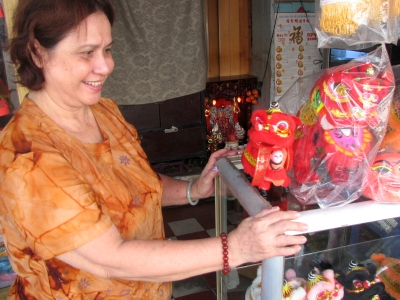 As I moved towards the street, the shopkeeper, a robust woman in matching Mickey Mouse pajamas, came over. She asked me if I like the watch, and I said yes but I didn’t want it.
As I moved towards the street, the shopkeeper, a robust woman in matching Mickey Mouse pajamas, came over. She asked me if I like the watch, and I said yes but I didn’t want it.
Not one to take no for an answer, she held it up to my face and asked how much I would pay for it. It seemed like I wouldn’t be getting out of there without going through all the motions, so I asked her the cost.
180,000 dong ($11.25) for the fake Rolex. It was too expensive, I told her as politely as I could. I turned to walk away. Problem solved.
She grabbed my arm and asked again how much I would pay. Just to expedite my getting out of there, I gave a price that was so low she would have no choice but to kick me out.
“70,000 dong,” I told her. About $4.37USD.
She slapped her hand to her forehead. “No! I cannot! Too cheap. 150,000?”
I shrugged. “Nope, 70,000. I guess I’ll be on my way . . .”
“Okay, Okay. I give you 110,000 because we are friends.”
But not the kind of friends that drive you to the airport. “No. 70.”
“100? No, I mean 90? 90,000?”
“No.”
“80? 85? 70 Okay. Yes, 70,000 Okay.”
She bargained herself. I pretty much had to buy it at that point.
Besides, it served the purpose of heartily impressing my Vietnamese co-workers. Bargaining past half the original price was unheard of, even among locals.
Too bad it broke within 24 hours of purchase. And too bad there are no warranties in Vietnamese markets.
By Whitney Cox

About the Author
 Whitney Cox is now living in Wellington, New Zealand, where she is slowly completing a post-graduate degree. She writes about traveling and living in New Zealand at FurtherThanYouThink.com.
Whitney Cox is now living in Wellington, New Zealand, where she is slowly completing a post-graduate degree. She writes about traveling and living in New Zealand at FurtherThanYouThink.com.
The post 3 Tips To Haggling Prices In Vietnam appeared first on The Expeditioner Travel Site.
]]>The post Visiting Tam Coc, “The Halong Bay On The Rice Paddies” [Video] appeared first on The Expeditioner Travel Site.
]]>Tam Coc, Vietnam (or as Lonely Planet dubs it, “Halong Bay on the rice paddies”), is named after the low caves that the Ngo Dong River flows, and which visitors are guided through, usually by a female rower. The longest, Hand Ca, is over 400 feet long, and is an impressive way to spend a couple hours in northern Vietnam.
[Tam Coc, Vietnam by Khalid Ghali/Vimeo]
The post Visiting Tam Coc, “The Halong Bay On The Rice Paddies” [Video] appeared first on The Expeditioner Travel Site.
]]>The post 7 Tips For Travel In Southeast Asia appeared first on The Expeditioner Travel Site.
]]>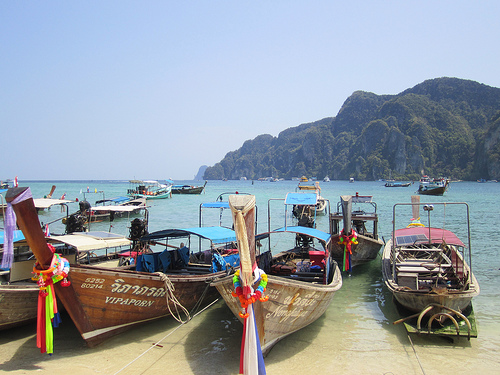
Southeast Asia is probably the best place in the world for your first extended backpacking trip. The food is delicious, the locals friendly, the beaches extraordinary, the accommodations well-established and the sites varied and unforgettable. You’re likely to return home with plenty of fond memories and incredible photos of Southeast Asia. If you’re considering setting off for Thailand, Malaysia, Laos, Cambodia, Vietnam, or any other country in the region, keep these tips in mind.
1) Stay Longer in Fewer Places
One of the biggest mistakes I saw was travelers rushing through an itinerary with too many places in too little time. No matter how long your trip is, it’s advantageous to go fewer places, while spending more time in each place. I would also encourage you to take more time than you think you need or want. Chances are you’ll wish you had more time.
On my recent trip to Southeast Asia, I saw one young backpacker who had begun to resent the region. He had been pushing too quickly to “see” whatever it was that he thought he had to see, ran into some unexpected difficulties and got extremely frustrated. Take it more slowly and you’ll have a better trip.
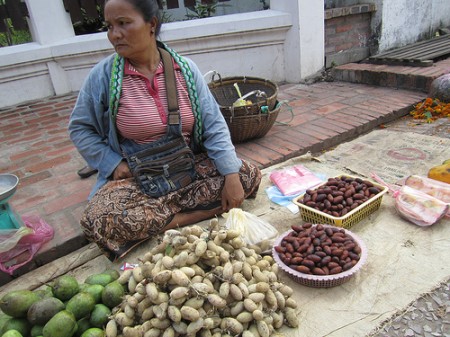 2) Don’t Plan Too Much
2) Don’t Plan Too Much
Leave room for spontaneity. That’s part of what makes traveling fun. You might want to plan a basic outline of the major places you want to visit. But give yourself plenty of time to absorb the atmosphere of the cities and villages and leave time in case you meet people and decide to do an impulsive side trip.
There’s no need to make reservations anywhere in Southeast Asia. You can just show up and shop around for your accommodation. I traveled for three months and never made one. I had a roof (and an inexpensive one I’ll add) over my head each night.
3) Travel With a Different Guidebook
Everybody has a Lonely Planet guidebook. Don’t buy one. Get a Rough Guide, Moon or Footprint. Lonely Planet channels everyone into the same guesthouses and hostels and that drives prices up. Plus, these guesthouses fill up more quickly. A good tactic is to check out a few guesthouses located around the ones listed in your guidebook. They are usually of the same standard and sometimes cheaper. I also always look at more than one place . Bargain friendly, and take the one that suits you best.
I generally choose my guidebook by the one that has been updated most recently. And remember, if at times of weakness, you are missing your LP, chances are the backpacker on the bus in the seat next to you has one.
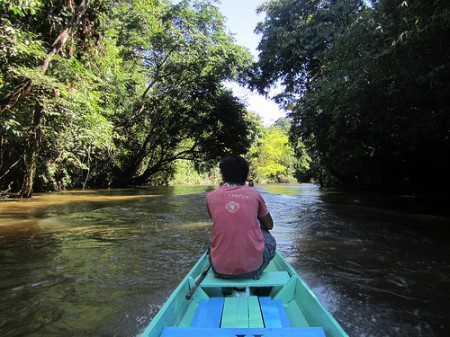 4) Avoid Multi-Day Packages and Backpacker-Only Buses
4) Avoid Multi-Day Packages and Backpacker-Only Buses
These are designed to make traveling easier. Organizers facilitate border crossings, transportation connections, accommodation and sometimes visas. In my opinion, this takes the fun and challenge out of independent travel. Figuring out transportation logistics is half the battle of traveling. Our detailed guidebooks make it easy enough, anyway. The multi-day packages also keep backpackers together and discourage interaction locals.
Another reason to avoid these packages, as well as international buses and VIP buses, is that you become an easier target for scams. In general Thais are pretty honest people, except when it comes to the individuals running the foreigner-only long distance buses from Khaosan Road to the rest of Thailand. I’ve heard some nasty stories of long delays, stranded travelers and multiple accounts of theft. Best to keep to the normal buses that leave from the bus stations.
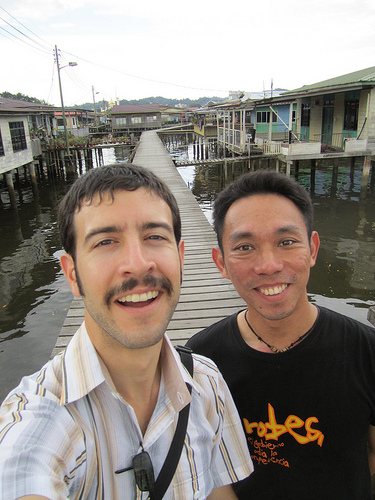 5) Travel With a friend; Travel Alone
5) Travel With a friend; Travel Alone
If you are traveling alone, great, you will meet plenty of people, both local and fellow travelers. If you are traveling with a friend, you will get lots of quality time with that person. Try to structure time away from your travel companion for a couple of reasons.
First, it will give you the independence to experience traveling on your own: meeting new people, making your own mistakes and choosing your own adventures. Secondly, it will improve and strengthen your relationship with your friend/partner when you return to each other. I used this scenario during two different trips with a good friend and it worked well. I also noticed that I have different and richer travel experiences when I’m alone.
6) Pack Light
This is one of my universal travel truth tips. It is always a good idea to pack as light as possible. Remember, you’re carrying everything on your back. Carrying less will obviously be lighter and increase your mobility, but it will also make getting in and out of transport, and to and from your accommodation easier. There’s really no need to take more than three or four changes of clothes.
If you’ll be working from the road or are a serious photographer, you might have a decent amount of equipment (extra lenses, external storage devices and laptops). But, most of us can just hit the road with a medium-sized backpack and small personal bag for valuables. I generally put nothing of value in my backpack. Although crime and theft in Southeast Asia is very unusual, I still want peace of mind when I throw my bag under or on top of the bus. And if your backpack is small enough, you may be able to carry it on with you, including during your flight, which could also save you money.
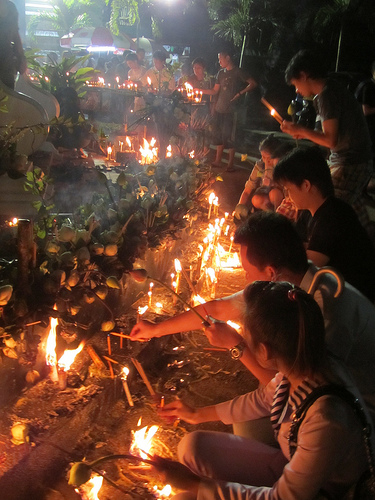 7) Avoid Burnout
7) Avoid Burnout
If you’re going to be traveling for more than two months, you’re going to need to recharge your batteries. Everybody does this in his or her own way. It could be alone with a book, a film, spending a day inside a nicer hotel room, eating comfort food, playing football — whatever.
Know yourself and know what you need to get a fresh perspective of where you are and what you’re doing. I’ve seen travelers get really frustrated and begin to develop animosity towards the country that they’re in at the time.
Author Paul Theroux, in his latest book, suggests bringing reading material unrelated to the country in which you’re traveling. At the end of a culturally intense day in Cambodia, you probably don’t want to wind down by reading a book that takes place in Southeast Asia. Rather, take one that will provide some relief through means of escape.
[All images via the author]

About the Author
 Stephen Bugno has been traveling the world for more than a decade as both a volunteer and a wanderer, and is the editor and publisher of the online travel magazine GoMadNomad.com and his personal site BohemainTraveler.com. You can follow Stephen via twitter at @bohemiantrav or on Facebook.
Stephen Bugno has been traveling the world for more than a decade as both a volunteer and a wanderer, and is the editor and publisher of the online travel magazine GoMadNomad.com and his personal site BohemainTraveler.com. You can follow Stephen via twitter at @bohemiantrav or on Facebook.
The post 7 Tips For Travel In Southeast Asia appeared first on The Expeditioner Travel Site.
]]>The post Setting Sail In Ha Long Bay [Video] appeared first on The Expeditioner Travel Site.
]]>Fresh from the crop of travel videes from our “Travel Videos” Vimeo group comes Asiantrip TV’s mini-epic from the Ha Long Bay portion of their trip in Southeast Asia. Yes, that is dreary fall outside your window you’re looking at. Yes, these French students are having way more fun than you right now. Cruel, cruel world.
The post Setting Sail In Ha Long Bay [Video] appeared first on The Expeditioner Travel Site.
]]>The post A Vietnamese Tourist In Vietnam appeared first on The Expeditioner Travel Site.
]]>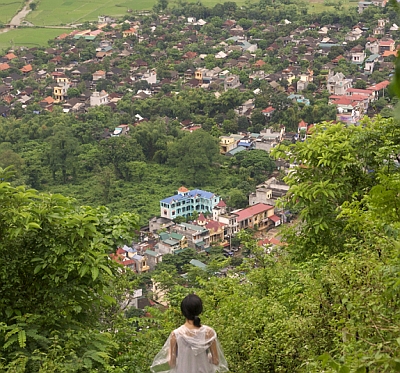
“I’m Drunk!”
I found Sue sitting on a bamboo bench basking in the glare of a dangling florescent light bulb. The bench was directly below the communal stilt house we were sharing, but we hadn’t spent much time at home. Sue kept an exhausting itinerary that I had no choice but to follow and, after two days posing as a Vietnamese tourist in Vietnam, I was longing for some sleep.
 Earlier, Sue took me on a tour of town, “free of charge,” but everything she showed me I’d seen before. Yet, to see it with Sue was to see it through new eyes . . . crazy eyes. I could never be quite sure if she had one glass eye or just one that was extra enthusiastic. Even her smile, which remained affixed in her sleep, curled further up the right side of her face.
Earlier, Sue took me on a tour of town, “free of charge,” but everything she showed me I’d seen before. Yet, to see it with Sue was to see it through new eyes . . . crazy eyes. I could never be quite sure if she had one glass eye or just one that was extra enthusiastic. Even her smile, which remained affixed in her sleep, curled further up the right side of her face.
Sue was living proof that you could get away with anything with a smile, however wonky that smile may be. She didn’t have a camera of her own so insisted that an Austrian tourist, Martin, take photos of her with his. Having no intentions of ever receiving these shots, she simply reveled in flashing her smile in peculiar places.
From Saigon but working in Hanoi, Sue was making her first trip to Mai Chau. She too was a tourist here (fanny pack and all), but likened herself as my guide.
And she liked getting drunk.
Before I met Sue . . . there was Minh.
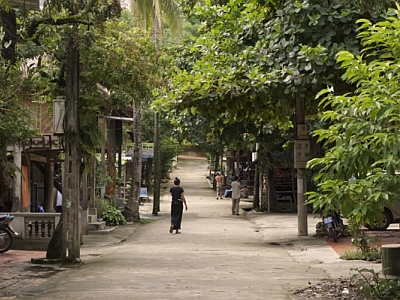 Fashionable in a Japanese style with cropped hair and flashy outfits, Minh cradled her boyfriend like an accessory. Silent but smiley, he appeared used to her whimsy. Together, they stayed in Miss Swan’s house down the road but, in order to practice her English, Minh kept nearby to act as my unofficial guide. She sat down across from me at lunch my first day in town, introduced herself, and took over from there. Minh gave me my initial tour of Mai Chau, the one Sue amped up the following day.
Fashionable in a Japanese style with cropped hair and flashy outfits, Minh cradled her boyfriend like an accessory. Silent but smiley, he appeared used to her whimsy. Together, they stayed in Miss Swan’s house down the road but, in order to practice her English, Minh kept nearby to act as my unofficial guide. She sat down across from me at lunch my first day in town, introduced herself, and took over from there. Minh gave me my initial tour of Mai Chau, the one Sue amped up the following day.
The antithesis of other Hanoians, Minh was bubbly, welcoming, patient, and incredibly chatty. She studied international diplomacy at Vietnam National University, though she’d never left Vietnam. She’d hardly been outside of Hanoi (this was her first time to Mai Chau), but you’d never know it the way she’d spout out information. Minh arrived into and completely took over my trip so fast that I never questioned her perplexing appearance.
Together, we enjoyed this quiet hamlet just four hours west of Hanoi. Billed as the closest place to view ethnic tribes, the area is home to the White Thai who’ve found their niche in scarf making and cultural dances — this to attract tourists, mostly locals, who arrive on weekend getaways to delight in a piece of Vietnamese heritage.
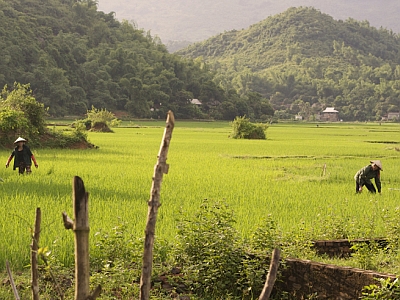 Minh, on her own weekend pilgrimage, took me biking through the rice paddies while keeping a running diatribe as she peddled. The area was a sun-drenched oasis in the cement-covered landscape of modern Vietnam. With a burgeoning population of over eighty million, there are few places left in the country that look like the iconic Vietnam of the Western imagination. That is to say, there are few places left with sprawling rice paddies bespeckled by conical hats and billowing buffalos. Encasing this in a fortress of gnarly mountains, Mai Chau was the quintessential Vietnamese watercolor, bestowing the kind of vistas that sell postcards and tote bags.
Minh, on her own weekend pilgrimage, took me biking through the rice paddies while keeping a running diatribe as she peddled. The area was a sun-drenched oasis in the cement-covered landscape of modern Vietnam. With a burgeoning population of over eighty million, there are few places left in the country that look like the iconic Vietnam of the Western imagination. That is to say, there are few places left with sprawling rice paddies bespeckled by conical hats and billowing buffalos. Encasing this in a fortress of gnarly mountains, Mai Chau was the quintessential Vietnamese watercolor, bestowing the kind of vistas that sell postcards and tote bags.
After our cycle, Minh invited me to Miss Swan’s house. Making herself at home, she prepared tea while prying Miss Swan for information as if introducing her own grandma. A White Thai who moved down from the hills twenty years ago, Miss Swan still spoke only a few words in Vietnamese, a few in English and some unintelligible gargle in between. She kept a logbook of all her visitors like a signed yearbook, showing it off with pride. She hadn’t seen the world, but the world came to her.
That night, Miss Swan, Minh, the silent but smiley boyfriend, and I watched the cultural dances under the self-same light I would find Sue the next evening. Day one’s peacefulness gave way to day two’s insanity when Minh waved goodbye and Sue burst out of the local bus.
As my unofficial guide, Minh was a flutterer. Sue took a more hands-on approach. Demanding (on my behalf) more food at dinner, ordering local women to give her photographer Martin and I weaving demonstrations, and parading us around town, Sue was the Tasmanian devil of her own Looney Tune world.
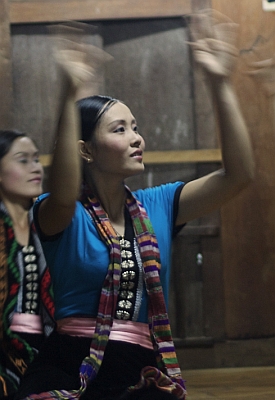 Each of the town’s various cultural dances finished with endless rounds of bamboo hopscotch and communal drinking. For these two reasons alone, Sue had plotted a loop around Mai Chau. She was a cultural dance junkie feening for the show-ending jug’s porcupine of bamboo straws. I found out much too late that at the bottom of that jar was a secret — that the grainy substance was not rice residue, as I had assumed, but a colony of dead bees.
Each of the town’s various cultural dances finished with endless rounds of bamboo hopscotch and communal drinking. For these two reasons alone, Sue had plotted a loop around Mai Chau. She was a cultural dance junkie feening for the show-ending jug’s porcupine of bamboo straws. I found out much too late that at the bottom of that jar was a secret — that the grainy substance was not rice residue, as I had assumed, but a colony of dead bees.
Rice whiskey with a hint of bumble.
Sue, with that kooky smile, ushered us to the final show (my fourth) with a group of wobbly Vietnamese businessmen. Why? Because the drunkest one of them all was carrying (and spilling) a large jug of rice whiskey. Halfway through the show, he kicked the drummer out and took over while his friend inched towards the soloist on stage as she wept over her lost lover. Sensing that the show was headed down a slippery slope, the dancers skipped to the bamboo hopscotch and communal drinking.
After the show, the dancers offered us special shots, the businessmen force-fed us more and somewhere along the way Sue stumbled home — her unofficial guide duties officially over.
I never call anyone I meet on the road crazy because I can never be quite sure on what scale to judge them by, but I’m pretty sure Sue was crazy. I certainly didn’t meet anyone else like her in Vietnam. Maybe being a tourist in your own country gives you a free pass to be wild — like exploring your American heritage by getting hammered at a Navajo Casino. I don’t know. What I do know is that Sue is a government worker back in Hanoi and the Vietnamese government could use a few more sunflowers in a field of weeds.
With Minh and Sue, I stepped into the shoes of a whole different kind of visitor: the domestic tourist. They’re a strange breed of traveler; close enough to have a privileged advantage on the foreigner but not quite at home. They are pilgrims, pilots and party-makers who feel the need to wear the hats of both host and holidaymaker to present a country that they themselves haven’t even seen.
They are the secret ticket in for us hapless foreigners as free, willing, often demanding guides. These domestic tourists, crazy-eyed or otherwise, can make you drink bees, introduce you to strangers, teach you how to weave, and show you their country in a way impossible on your own. They’ll turn you into a Vietnamese tourist in Vietnam . . . if you can handle everything that entails.
By Mark Johanson

ABOUT THE AUTHOR
Mark Johanson is a travel writer and photographer based out of New York City. Currently the travel editor of International Business Times (IBTraveler.com), his musings and photos can be found on his blog, MarkOnTheMap.wordpress.com.
The post A Vietnamese Tourist In Vietnam appeared first on The Expeditioner Travel Site.
]]>The post How To Tell The Story Of Hanoi In Minutes [Video] appeared first on The Expeditioner Travel Site.
]]>A lesson I’ve yet to learn in my own videos is that sometimes, in travel videos, it’s best to just shut your trap and let the destination do the talking. I mean, let’s be honest, it’s not you the viewers are really looking to see, it’s the destination. Case in point, the above video of Hanoi shot by Matt Devir that utilizes some fancy camera work and ambient music to tell a story much richer and moving than any words could ever do.
From the juxtaposition of the iconic image of women carrying baskets strung on a pole across their shoulders against the backdrop of one of the fastest industrializing cities in the world, to the shots of the night market filled with teenagers having dinner while crowded around small tables, Hanoi seems to be telling a story at nearly every street corner within its bustling borders, and beckoning the eager listener to sit down for the tale.
[The Expeditioner Travel Video Group/Vimeo]
The post How To Tell The Story Of Hanoi In Minutes [Video] appeared first on The Expeditioner Travel Site.
]]>The post The Expeditioner’s May Travel Photo Contest Winner: Hanoi Eatery appeared first on The Expeditioner Travel Site.
]]>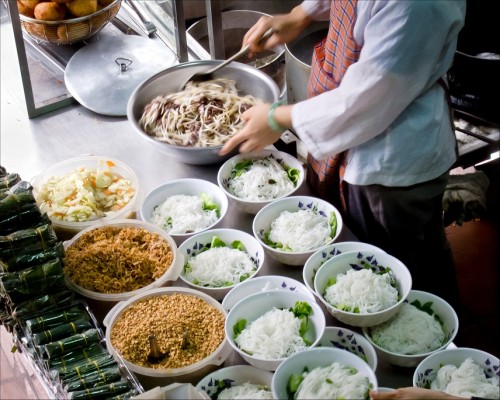
Dear Hanoi, you can have your cacophony of unrelenting horns. Me? I’ll revel in the bliss that is your cuisine. This month’s photo contest winner, Jonathan Hall, did just that. In his own words:
Hanoi’s dining scene can be daunting at first as there are rarely any menus. You just walk along until you see something that looks good, sit down and communicate how many portions you want. At 67 Hang Dieu Street, Hanoi, Bun Bo Nam Bo is typical of Hanoi’s street eateries in that they only do one dish, and they do it well.
The restaurant itself is always busy and will test your ability to sit comfortably on Hanoi’s ubiquitous tiny plastic stools. It is a deep, narrow cave of a restaurant that somehow also manages to fit in a second, mezzanine level. As an accompaniment to what you see in the photo, they also serve Nem Chua, which is a pressed, cured pork sausage rolled up in a banana leaf, which explains the excess of green detritus on the restaurant floor. The clientele is young and hip and located right in the middle of Old Hanoi.
This shot is a quality recipe of lighting, action, still, and delicious. However, for Luke, it was awful. Terrible. And never again should Team Expeditioner vote on a contest winner, as delicious as this shot, on a day that Luke skips breakfast. Sorry man, we’ll plan a little better in the future.
Congratulations to American Jon and his shot of Bun Bo Nam Bo from Hanoi. Take a phenomenal photo tour through his shots and experiences from London to Laos by clicking through to his Flickr page.
Our June Contest is ready to roll! There are those moments when you stand at the foot of the precipice, or on top of a mountain, and before you is a sight never to be forgotten. Those moments when our eyes make us stop and take it all in. So many places remind us of these moments. Our next photo contest, lasting throughout the month of June, TheExpeditioner.com asks, “Where’s your inspiration?” Is it a view to the horizon or a view into history? Whatever it may be, submit your shots of “Inspring Vistas” for a chance to win June’s travel photography contest at The Expeditioner’s Flickr group.
By Jon Wick

About the Author
 Jon lives in Butte, Montana, spending most of his time on skis or bikes; sometimes both. He began travel writing while teaching in Korea and is currently pursuing his Master’s Degree in Technical Communication at Montana Tech. Jon has begun writing his first book, The Story of Will, whose movie rights are still (very) available. Catch more of Jon at TheJonWickproject.wordpress.com. (@ExpedJon)
Jon lives in Butte, Montana, spending most of his time on skis or bikes; sometimes both. He began travel writing while teaching in Korea and is currently pursuing his Master’s Degree in Technical Communication at Montana Tech. Jon has begun writing his first book, The Story of Will, whose movie rights are still (very) available. Catch more of Jon at TheJonWickproject.wordpress.com. (@ExpedJon)
The post The Expeditioner’s May Travel Photo Contest Winner: Hanoi Eatery appeared first on The Expeditioner Travel Site.
]]>The post 8 Coffee Shops In Saigon You Need To Try appeared first on The Expeditioner Travel Site.
]]>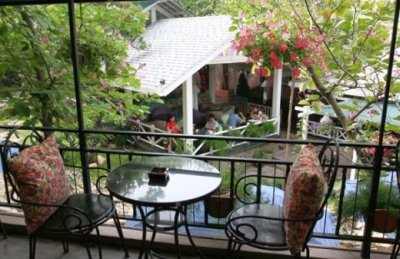
Travelers who’ve downed a cup of joe in Southeast Asia know that the stuff’s good — really good — but not like what you’re used to at home. Given the coffee’s brewed from extra-bold beans and served in a climate where the last thing you crave while you’re sweating through your shirt is a hot drink, the average cup there is served over ice and mixed with a healthy dose of condensed milk to make it a little more palpable. And for those looking for a little respite in the craziness that is Saigon, the LA Times put together this list of the top 8 coffeehouses in Saigon.
In putting together their list, they put a special emphasis on relaxation, naming such spots as Mien Dong Thao (pictured above) that features waterfalls and tropical plants in their backyard, and Niet Ban, a Buddhist-influenced cafe with soothing music and a koi pond. Oh, and don’t expect a to-go cup. I tried, and I after a little bit of “lost in translation,” I ended up in the street with a ceramic mug that I had just bought and a coffee vendor considering going into kitchenware sales.
By Matt Stabile

ABOUT THE AUTHOR
 Matt Stabile is the Founder and Editor-in-Chief of The Expeditioner. The Expeditioner began in 2008 and is headquartered in New York City. You can read his writings, watch his travel videos or contact him at any time at TheExpeditioner.com. (@TheExpeditioner)
Matt Stabile is the Founder and Editor-in-Chief of The Expeditioner. The Expeditioner began in 2008 and is headquartered in New York City. You can read his writings, watch his travel videos or contact him at any time at TheExpeditioner.com. (@TheExpeditioner)
The post 8 Coffee Shops In Saigon You Need To Try appeared first on The Expeditioner Travel Site.
]]>The post Vietnam By Bike: The Greatest Trip On Earth appeared first on The Expeditioner Travel Site.
]]>
Let’s pretend for a moment that I’m a jacked-up, grease-loving, motorhead that feels at home in leather pants. I would boast of my vehicular chariot’s duel exhausts, 454 “ponies under the hood,” and chrome-plated deely-bops. I’d even have the Kia logo tattooed on my right forearm. Also, I can get away with a Kia tattoo on my arm because my last name was changed to Badass.
Well, Mr. Badasses don’t lounge at home watching Anthony Bourdain reruns while rearranging their wall hangings to make room for the postcards they want to hang on the living room wall (I’m not saying I’m that guy, either). Badasses crack open an Old Milwaukee and turn on BBC’s Top Gear, the British show featuring three hilarious friends spotlighting the latest and greatest products from the world of cars . . . and automotive deely-bops.
For the sake of continuing our imaginative exercise, let’s say we pop over to Top Gear only to see a Vespa zipping along a remote beach and through dense jungles. Seconds before the bike pulls into a tiny, remote village, we realize this isn’t happening anywhere near the U.K. Interest peaked, you lean a little closer to find out the destination of your next motor-biking trip abroad.
Vietnam’s Highway 1, from Saigon to Hanoi has reeled in another believer.
Lonely Planet recently laid out several trips in both Vietnam and Cambodia that will convince anyone of a two-wheeled tour through the up-and-coming motorbike Mecca:
The gorge road from Dong Van to Meo Vac is the stuff of biker yore, its towering cliffs looming high above and plummeting to the Nho Que River in the distance below. Just remember to keep an eye on the road, despite the breathtaking scenery.
In Cambodia, get your kicks on the new Route 66:
An ancient Angkorian highway that runs due east from Angkor via Beng Mealea to the vast temple complex of Preah Khan. Ancient stone bridges from the time of Jayavarman VII acts as historical waymarkers along the route, including the dramatic Spean Ta Ong with more than 20 arches.
The visions of unbridled road stretching on for miles, through jungles and over ancient stone bridges, we settle back down into our couch and continue watching Top Gear. The thought strikes: There may be no need for black leather chaps when mingling with villagers along the route. And there’s really no reason for loads of horsepower when your goal is the experience rather than the status. In this part of the world, and from the seat of your motorcycle, there are experiences sure to be had.
Now, I’m off to the market. I just finished my last Old Milwaukee.
[Photo by Mr Chris Johnson/Flickr]
By Jon Wick

About the Author
 Jon lives in Butte, Montana, spending most of his time on skis or bikes; sometimes both. He began travel writing while teaching in Korea and is currently pursuing his Master’s Degree in Technical Communication at Montana Tech. Jon has begun writing his first book, The Story of Will, whose movie rights are still (very) available. Catch more of Jon at TheJonWickproject.wordpress.com. (@ExpedJon)
Jon lives in Butte, Montana, spending most of his time on skis or bikes; sometimes both. He began travel writing while teaching in Korea and is currently pursuing his Master’s Degree in Technical Communication at Montana Tech. Jon has begun writing his first book, The Story of Will, whose movie rights are still (very) available. Catch more of Jon at TheJonWickproject.wordpress.com. (@ExpedJon)
The post Vietnam By Bike: The Greatest Trip On Earth appeared first on The Expeditioner Travel Site.
]]>The post December’s “Christmas Around The World” Photo Contest Winner: A Ho Chi Minh City Santa Hat appeared first on The Expeditioner Travel Site.
]]>
It never ceases to amaze us when two people are on the same page, let alone 8 million. We learned from our December photo contest at our Flickr group, that this is exactly the case every December in Vietnam’s Ho Chi Minh City. Our Christmas-themed contest winner comes from AMASC and is titled “Balloon Gazing.” She is the one that schooled us on the city’s Christmas custom:
During December, Ho Chi Minh City or Saigon (call it what you will), is home to the largest collection of people wearing Santa hats in the world. Everyone does it, taxi drivers, waiters, random adults, school kids but especially children. From the beginning of December the Christmas decorations go up and the main occupation of this city of 8 million is to dress your child like Santa and grab a few hundred images of them in front of the decorations, the hawkers and the other little Santas.
We really gravitated to this photo because, to us, it really grabs the essence of traveling during the holidays. Matt agrees: “I think nothing is cooler when traveling than seeing those incongruous images, like Christmas decorations in a hot climate in Southeast Asia.”
For more images from SE Asia, holiday oriented or not, head over to her photostream or blog full of spectacular shots. It may just plant a seed in your mind to spend next year’s holiday void of snow. I know I’m considering it. Chúc M?ng Giáng Sinh everyone — Merry Christmas.
With all this winter stuff going on, we thought we’d take a little break from it all and dream of those island getaways, bungalows, drinks served with umbrellas and inside some kind of fruit you’ve never seen before. January’s theme is “Island Vibes.”So relive those beachside massages all over again while you upload your island getaway shots to our contest thread.
The post December’s “Christmas Around The World” Photo Contest Winner: A Ho Chi Minh City Santa Hat appeared first on The Expeditioner Travel Site.
]]>The post October’s “Adventure Travel” Photo Contest Winner appeared first on The Expeditioner Travel Site.
]]>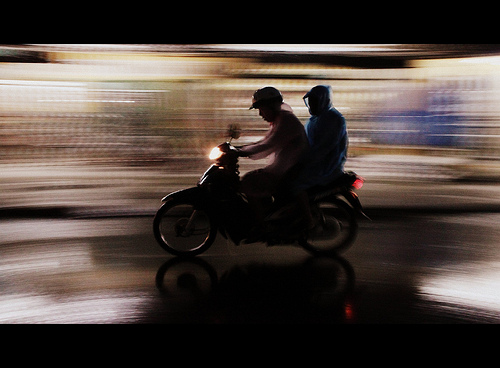
This month’s contest winner brings back memories for some of us at The Expeditioner. With Matt recently back from his escapades through Cambodia and Vietnam, he can vouch for me when I say that routine travel in SE Asia can, in it of itself, be considered “adventure travel” in the most literal of terms. This fantastic shot was taken by Phong in Hoi An, Vietnam. It sounds like quite the moment:
I got caught in a storm and had to take cover under a local store in Nhi Trung St. alleyway. As I sat there, I pulled out the camera and just took a shot. I got to say sitting in the storm was just the most amazing thing . . . the thunder rumbling through my body in a foreign land and the light show . . . words cannot describe . . .
We understand. Not often does a photograph make me feel like unleashing a “whoop” onto this coffee shop, but this white-knuckle motorcycle ride definitely does.
More of Phong’s amazing photos of his trips can be found at his Flickr photostream. Honestly, check them out — they’re enough motivation to tolerate a bad case of jet lag in Vietnam.
Next month’s photo contest is already up and running on The Expeditioner Flickr page. We are looking forward to seeing the pageantry and spectacle of . . . “World Festivals.” Click here for the thread and post away!
The post October’s “Adventure Travel” Photo Contest Winner appeared first on The Expeditioner Travel Site.
]]>The post SE Asia Trip Dispatch: Part Three (Saigon Part Duex) appeared first on The Expeditioner Travel Site.
]]>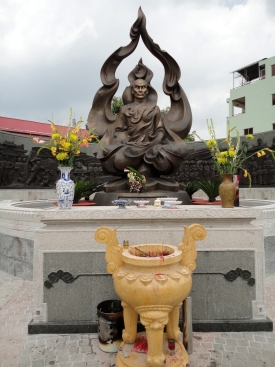
On June 11, 1963, Buddhist monk Thich Quang Duc set himself on fire to protest the treatment of monks by American-backed President Ngo Dinh Diem. This act led to the steep decline of the support of the President, and is widely believed to be the end of his reign, culminating in his assassination in November of 1963 with the backing of the Kennedy administration, and ushering in the beginning of even higher tensions in the country.
Today a poignant memorial stands at the intersection where his self-immolation occurred, another reminder around the city of the troubled history of the country. Incense is burned at the base of the statue, and candles are burned in honor of his sacrifice.
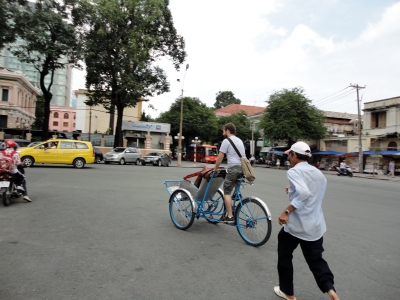
I came to the statue by cycle rickshaw, an extremely touristy activity (a word I try to avoid at all costs on this site), that I can’t say I’m too proud I took part in, but come on, if you’re offered the chance to ride around the streets of Saigon by open bicycle for a small fee and with a knowledgeable guide, it’s hard to say no. The embarrassing part came when I realized I was out of money and I was forced to work off the trip for the rest of the day by doing my own tours, but at least I got a little bit of exercise.
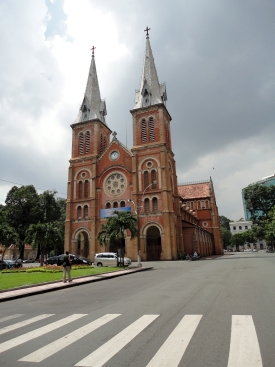
In the heart of the city is Notre Dame Cathedral. Begun in 1863, this massive cathedral took almost 20 years to construct, and its 190-foot towers surely must have been the tallest structure in the city for decades (of course it is now quickly being overshadowed by the numerous tall glass towers that have recently gone up).
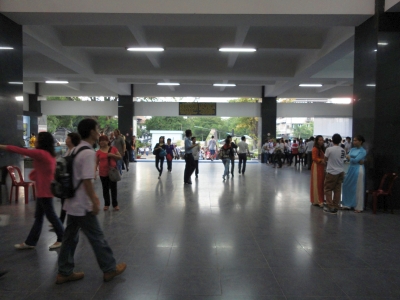
I finished the day up by visiting the War Remnants Museum, a museum dedicated to the American War. Numbers can be bantered around — over 2 million Vietnamese alone were killed during the conflict — but until you see the pictures and read the descriptions by those who lived through it can you begin to attempt to comprehend the carnage. The museum not only includes various military equipment left behind after the war and a good description of the events that took place, but it also includes a poignant exhibit documenting the devastating effect that Agent Orange had on both those who it was used against as well as those handling it.
The post SE Asia Trip Dispatch: Part Three (Saigon Part Duex) appeared first on The Expeditioner Travel Site.
]]>The post SE Asia Trip Dispatch: Part Two (Saigon: First Impressions) appeared first on The Expeditioner Travel Site.
]]>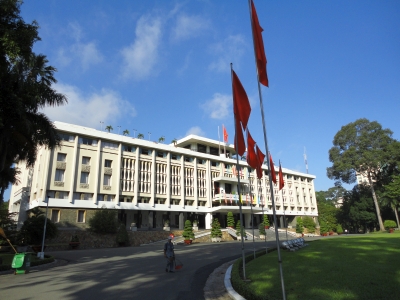
Jet lag does some strange things to the mind on the road. Waking up, sweating in the middle of the night, with no chance of falling back asleep, it sends your mind into some dark corners of the world, switching off all pleasure receptors and robbing you of all that you hold dear. But, alas, when the fog finally clears, the circadian rhythm jumps back in line, and the overhead sun no longer sends shivers down your spine when you step outside, the world comes back into focus, and you wonder what all the fuss was about.
But a step back one day, wandering the streets of District 1 at 6:50 a.m., already awake for several hours, I grabbed a mid-morning snack, a banh mi from a corner food stand, and made my way to Reunification Palace, perhaps Saigon’s most well-known landmark. It was here on April 30, 1975, that — as the blasting soundtrack on the post-tour DVD explained — the Liberation Army rolled its tanks through the ornate front gate and finally ended decades of colonial rule. For those in the West, this was known as “The Fall of Saigon,” but for most in Vietnam, it was the beginning of the end of foreign occupation, and the building is an important historical sight no matter how you view those fateful days in 1975.
The building that stands today is actually relatively new, having been built in 1962 on the same site after two defecting pilots bombed the former structure there, the Norodom Palace, the former home and offices to all of the French governors of Cochinchina from 1887-1945. Today the palace has been preserved in its Diem-era form, evoking the architectural style of the time. From the basement, where original maps from the war hang on the foot-thick reinforced walls of the basement, there is a staircase that leads to the roof’s helipad, the only other working helipad save for the American Embassy down the road.
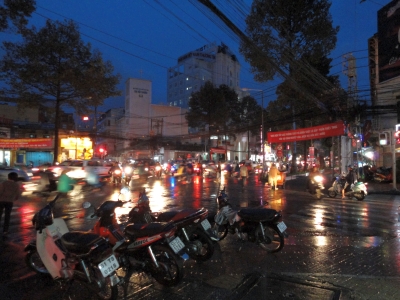
To say that the streets of Saigon are hectic is like saying the weather is hot here: it doesn’t even begin to accurately describe it. For practicality, and ease of use, the city’s streets are clogged at all hours, of motorbikes, scooters, and motorcycles driving elbow-to-elbow, occasionally choosing to obey the few street lights that attempt to control traffic here, and vying for space to change lanes and make turns when needed.
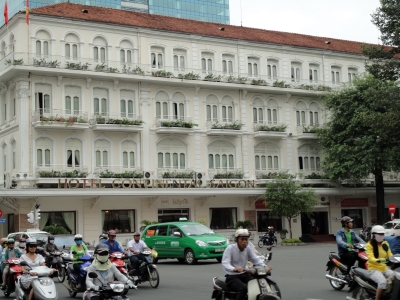
Which also means that crossing the street is, well, a learned skill. I can safely say I have crossed many the street in Saigon and I live to tell about it, and therefore I have faced death and defeated it (barely). If you should find yourself in this position, the best advice I can give to you is that drivers probably don’t want to hit you, and they will try really hard to avoid you.
That said, look for any microsecond of space between drivers, step foot into the street (remember when Indiana Jones takes that step into nothingness in “The Last Crusade”?) and make your way forward. You’ll basically see hundreds of cars and bikes careening your way, but more than likely they’ll part and and allow you to get across eventually. The last thing you want to do is show timidness. Sudden stops or changes in your speed causes drivers to miscalculate where you will be in a few seconds, and will cause more problems.
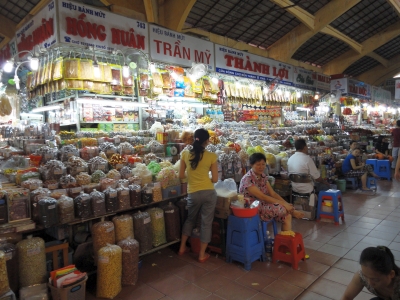
The food: well, what can I say that hasn’t filled travel articles and volumes of books already about the cuisine of Vietnam? Perhaps what is most noticeable about the food in Vietnam is the care that every person seems to have for it. Food here is not to be eaten quickly, or thoughtlessly for that matter, but rather something that time needs to be set aside for, and preparation needs to be taken at all hours. From the earliest hours of the day (and believe me, I was up for it), street corners and markets like Ben Tanh — the largest in the city — fill up with a cacophony of activity including peeling, dicing, cutting, mixing, slathering, and hawking, all for the onslaught of hungry eaters who pour into alleys outside their homes or onto street corners near their work for a bowl of soup, or for a plate of rice and prepared meat or fish.
Here is not a place to lose weight, or somewhere to be picky about what you eat. Dark alleyway bistros with tiny plastic chairs and a metal table will likely be the site of one of your best meals of the trip. Sit down, ask for what everyone else is eating, and enjoy, and do it all again in a few hours. You’ll likely be joined by a toddler playing games around your feet, a student eating across from you, and a grandmother cleaning her kitchen behind a window behind your head.
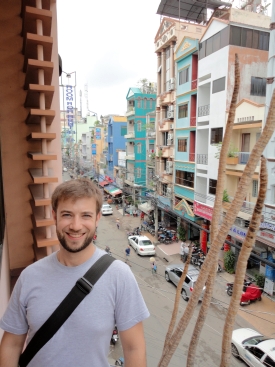
The honking of horns, the curious smells that waft out of every alley, and the constant attention of every street hawker, moto-driver and corner straggler is something that the long-term resident probably eventually gets used to, but it’s something that instantly seems to be noticeably lost the second your bus leaves the city, a piece of a puzzle that quickly goes missing.
The post SE Asia Trip Dispatch: Part Two (Saigon: First Impressions) appeared first on The Expeditioner Travel Site.
]]>The post SE Asia Trip Dispatch: Part One (When A Layover Becomes A Trip) appeared first on The Expeditioner Travel Site.
]]>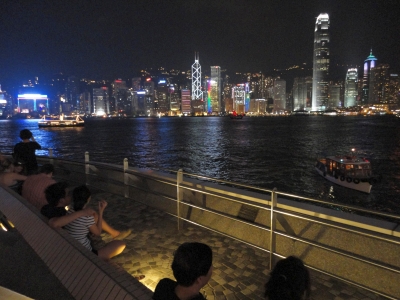
There are a couple of things you should keep in mind when planning to include a massive layover during your trip. One: despite its reputation, layovers are good. Especially when they’re in a city you’ve never been to before. Especially when it’s Saturday night. And especially when you have two weeks ahead of you to not worry about the consequences. And Two: Mind the jet lag, or what we in the medical profession refer to as “desynchronosis,” a disruption of the circadian rhythms that will cause irregular sleep patterns, shifts in mood, and the need to blog at 4:30 a.m. the next day after falling asleep around dinner time.
I wasn’t really sure what to expect from Hong Kong. Seeing as I was going to be there for roughly 12 hours, I kept my research and planning to a minimum, relying on the maxim that a little spontaneity goes a long way during travel. Given the city’s long history as a trading port, wits its deep harbor and strategic location, I somehow had this vision of a an old, colonial seaside port filled with salty merchants of the sea hawking fresh seafood and exotic goods from their travels. This is basically accurate, but substitute the sailors for Brooks Brothers-clad London Investment Bankers, and substitute the exotic goods for collateralized securities and designer handbags.
Hopping off the Airport Express train from the airport into the center of Hong Kong, I ran into a girl that was visiting her friend for a couple days before she too was off to Vietnam. We made plans to all meet up, along with some of their other friends that lived there, later on in Lan Kwai Fong, the party-hopping nightlife district.
Having a couple hours to spare, I asked the friend that lived there which of the two activities I should do to pass the time: take the peak tram to the top of Victoria Peak for views of the city, or take the famed Star Ferry across Victoria Harbor to Kowtoon, the location of the Temple Night Market.
“The Peak Tram,” she said, emphatically, “that is the real Hong Kong. The market is just a market, nothing special.”
And with that I exited the cool, climate controlled environs of the International Finance Center and hoofed my way outside into the humid, tropical-like air of the Pacific coast. 30 minutes later, after a trek through windy foot roads towered over by the building behemoths of the world’s largest financial enterprises, I found myself surrounded by Chinese tourists, in line with the intention of heading to the top of the peak too. Lines to me, while traveling, are like mosquito-borne illnesses: they should be avoided at all costs. I promptly turned my heels and headed back the way I came, and eventually onto the rickety wooden platform leading onto the Star Ferry.
Tracing its origins back to 1880, the lifesaver-lined ships have been an an important resource and symbol of the Hong Kong for over a century. Ferrying passengers around the harbor from all different points, the fifty-cent fare is more than worth the cost for the spectacular views you get as you cross the water. They are also a very slow and inefficient way to get from Point A to Point B (the subway underneath would cut that time to a fraction), but who’d want to miss out on seeing some of the world’s most iconoclastic night views?

It’s safe to say that hiking shoes, camouflage shorts and a day bag are not the preferred items of clothing one would wear for a Saturday night out in Lan Kwai Fong, Hong Kong’s take on NYC’s Meatpacking District and Miami’s South Beach, but with way more British and Australian bankers.
“Cheers mate,” a tall, smiling Brit said as we clinked glasses. We were standing outside a corner bar that specializes in the refined art of the flavored shots. “So who of these people do you know exactly?” he asked, motioning to the group of 10 of us standing around.
“Umm, actually, none,” I said. “Oh wait, I know those two girls over there, and by ‘know” I mean I met them a couple hours ago at the train station. How about you?”
“I know that guy, Matt, over there talking to the German and the Italian,” he answered. “We became friends a couple years back in Thailand. He sold his company in 2006 and used the money to buy a place here in Hong Kong as well as a boat in Thailand. I’m on my way back to Shanghai and I thought I’d drop him a visit.”
“Why’s the boat in Thailand?” I asked.
“That’s where he bought it, and we’ve been meaning to sail it around Singapore and up the along the coast until we get here so he can dock it. We started to do it last year, but we only made it about 60 miles until he came down with Dengue Fever and we had to call off the expedition.”
This conversation was basically the type of odd, random encounters that seem to be commonplace here. One minute you’re talking to a 40-year-old banker from London about the crash in 2008, the next you’re getting an explanation from a mother of two from Australia about why she and her friends are dressed up in disco clothes and roaming the streets at 3 a.m. (it was her husband’s friend’s birthday, if you were wondering). I had shots with a group also from New York who one of them, I think, works with somebody I know, a connection that could’ve better been explained but for the Shakira video that came on the T.V. that inevitably led the group to hop on the closest table and dance.
A hot, steaming bowl of noodles at a local shop near the train station, and a short ride back to the airport later, the sun’s rays began to emerge from beyond the towering mountainsides next to the airport, and through the massive wall of glass of the terminal, which, if you were keeping score, is the world’s 11th-largest structure in the world (6.3 millioin sq. feet). I lowered my sweatshirt hood and closed my eyes, seconds away from a short nap before boarding my flight to Saigon. With layovers, any little bit of sleep helps.
The post SE Asia Trip Dispatch: Part One (When A Layover Becomes A Trip) appeared first on The Expeditioner Travel Site.
]]>The post Phu Quoc, Vietnam: Visit Before It Becomes Phuket appeared first on The Expeditioner Travel Site.
]]>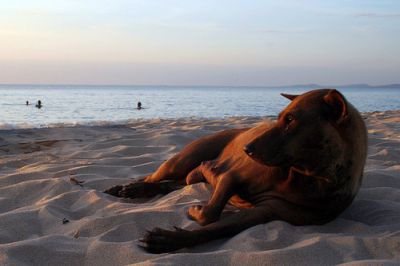
“Like Phuket before it became Phuket.” Anyone notice how this saying is quickly becoming the de facto description to use to describe an island in Southeast Asia that is, amazingly, undeveloped and seemingly undiscovered by tourists? (I recently wrote about this article about Boracay, Philippines — an island that also got the Phuket treatment). This description also popped up in this recent LA Times article about Phu Quoc, the small Vietnamese island that straddles the border with Cambodia.
“Phu Quoc, once known mainly for its pungent fish sauce and wartime history, is the hottest new tourist destination in Vietnam, a slice of tropical perfection with mile after mile of wide, uncrowded beaches, dense jungle, virgin rain forests and a lazy, laid-back atmosphere that reminds a visitor of what Phuket, Thailand, was like a generation ago.”
Which is not to say this is bad. There’s a reason people lust for the Phuket of yesteryear: they loved it. So what better compliment can you pay to an undiscovered place than that? Coincidentally, I just finalized my own plans to visit the island as a bookend to my trip to the region that begins next weekend.
But, alas, all good things must come to an end (and I haven’t even seen it yet). As the article sadly explains, things, however they are now, won’t last long. “The government has a master plan to develop Phu Quoc into a high-quality eco-tourism destination by 2020, when it aims to attract 2.3 million visitors a year. An international airport is scheduled to open in two years to accommodate nonstop flights from Japan, Thailand, Singapore and Hong Kong. Roads and bridges are being rebuilt and a deep-water port is being dug at An Thoi.” Another reason to get there soon.
The post Phu Quoc, Vietnam: Visit Before It Becomes Phuket appeared first on The Expeditioner Travel Site.
]]>The post The Quest To Avoid Tourists In Vietnam Continues appeared first on The Expeditioner Travel Site.
]]>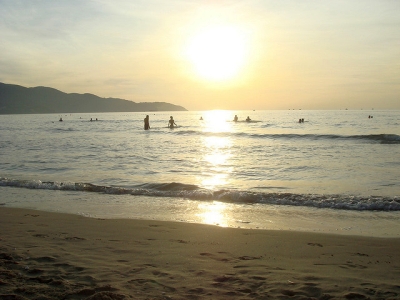
If you basically draw a line between the northern and southern tips of Vietnam, then mark the exact middle, you’ll find Da Nang, the former U.S. stronghold during the Vietnam (or American, depending on which country you were living in) War, and now an increasingly popular destination for travelers looking for a getaway in the South Central Coast of the country.
But as the SMH recently explained, this wasn’t always the case. “See, Da Nang never used to be a tourist destination. It was merely a beachside speed bump between two of Vietnam’s big hitters: the ancient capital of Hue, to the north, and the quaint, heritage-listed Hoi An to the south . . . Da Nang doesn’t have the history of Hue, nor the charm of Hoi An. What it does have are pristine beaches, cool mountain hideaways and the relaxation that comes with being away from most other tourists — and most of the people whose job it is to bug the other tourists — as well as beachside restaurants.” Sounds good for now, but how long will the un-touristy vibe last?
And there’s not just sun and eating to be had in Vietnam’s fourth-largest city, the city has some worthwhile museums as well, perfect for the rainy season. A visit to The Museum of the Fifth Military Zone Danang offers travelers a chance to see some relics of the French and American Wars, and the Cham Museum is home to hundreds of works of art from the 12th to 15th centuries, relics of the once mighty Champa Kingdom.
The post The Quest To Avoid Tourists In Vietnam Continues appeared first on The Expeditioner Travel Site.
]]>